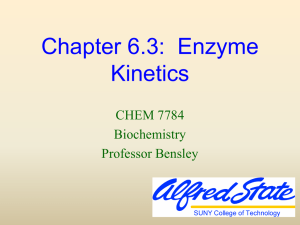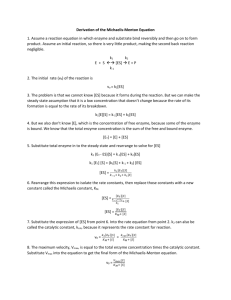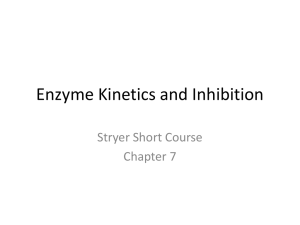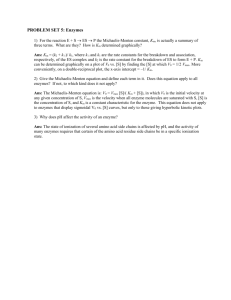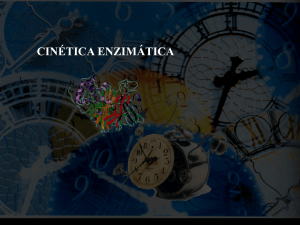Introduction to enzymes
advertisement
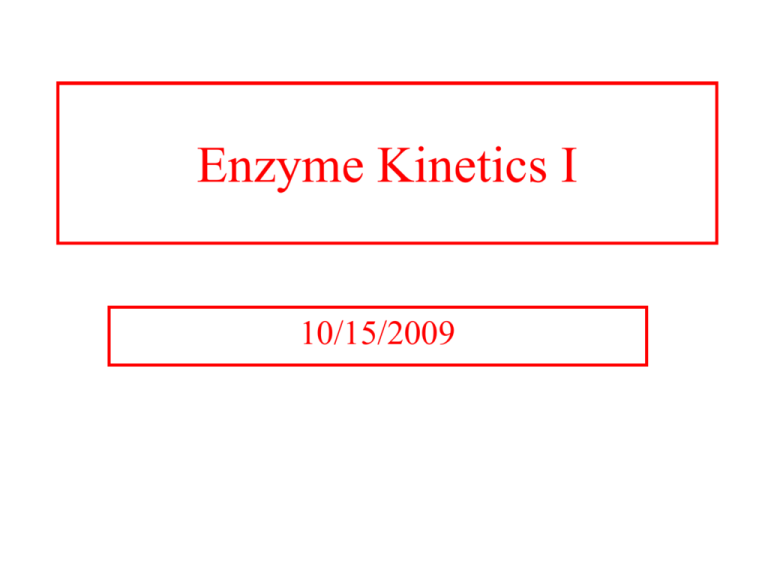
Enzyme Kinetics I 10/15/2009 Enzyme Kinetics Rates of Enzyme Reactions Thermodynamics says I know the difference between state 1 and state 2 and DG = (Gf - Gi) But Changes in reaction rates in response to differing conditions is related to path followed by the reaction and is indicative of the reaction mechanism!! Enzyme kinetics are important 1. Substrate binding constants can be measured as well as inhibitor strengths and maximum catalytic rates. 2. Kinetics alone will not give a chemical mechanism but combined with chemical and structural data mechanisms can be elucidated. 3. Kinetics help understand the enzymes role in metabolic pathways. 4. Under “proper” conditions rates are proportional to enzyme concentrations and these can be determine “ metabolic problems”. Chemical kinetics and Elementary Reactions Rate Equations Consider aA + bB + • • • + zZ. The rate of a reaction is proportional to the frequency with which the reacting molecules simultaneously bump into each other Rate kA B Z a b z The order of a reaction = the sum of exponents Generally, the order means how many molecules have to bump into each other at one time for a reaction to occur. A first order reaction one molecule changes to another AB A second order reaction two molecules react A+BP+Q or 2A P 3rd order rates A + B + C P + Q + R rarely occur and higher orders are unknown. Let us look at a first order rate AB dA dP v dt dt dA v k A dt n = velocity of the reaction in Molar per min. or moles per min per volume k = the rate constant of the reaction Instantaneous rate: the rate of reaction at any specified time point that is the definition of the derivative. We can predict the shape of the curve if we know the order of the reaction. A second order reaction: 2A P d A 2 v k A dt Or for A + B P + Q d A d B v k A B dt dt Percent change in A (ratio ) versus time in first and second order reactions It is difficult to determine if the reaction is either first or second order by directly plotting changes in concentration. dA k A dt A t dA k dt A A 0 o d A kdt A ln A ln Ao kt A Ao e -kt However, the natural log of the concentration is directly proportional to the time. - for a first order reactionThe rate constant for the first order reaction has units of s-1 or min-1 since velocity = molar/sec and v = k[A] : k = v/[A] Gather your data and plot ln[A] vs time. The half-life of a first order reaction A o A 2 Plugging in to rate equation Ao ln 2 A kt1 2 ln 2 0.693 t1 k k 2 The half-life of a first order reaction is the time for half of the reactant which is initially present to decompose or react. a common radioactive isotope, emits an energetic b particle and has a half-life of 14 days. 14C has a half life of 5715 years. 32P, A second order reaction such like 2A P dA o k dt 2 A o A 0 A t 1 1 kt A Ao When the reciprocal of the concentration is plotted verses time a second order reaction is characteristic of a straight line. 1 The half-life of a second order reaction is t1 and shows a dependents on the initial concentration k A o 2 Kinetics of Enzymes Enzymes follow zero order kinetics when substrate concentrations are high. Zero order means there is no increase in the rate of the reaction when more substrate is added. Given the following breakdown of sucrose to glucose and fructose Sucrose + H20 Glucose + Fructose H H H H OH O HO H H H O HO OH H HO H H OH OH OH OH H HO H k1 E S ES E P k2 k -1 E = Enzyme S = Substrate P = Product ES = Enzyme-Substrate complex k1 rate constant for the forward reaction k-1 = rate constant for the breakdown of the ES to substrate k2 = rate constant for the formation of the products When the substrate concentration becomes large enough to force the equilibrium to form completely all ES the second step in the reaction becomes rate limiting because no more ES can be made and the enzyme-substrate complex is at its maximum value. d P v k 2 ES dt [ES] is the difference between the rates of ES formation minus the rates of its disappearance. 1 d ES k1 E S k 1 ES k 2 ES dt Assumption of equilibrium k-1>>k2 the formation of product is so much slower than the formation of the ES complex. That we can assume: k 1 E S Ks ES k1 Ks is the dissociation constant for the ES complex. Assumption of steady state Transient phase where in the course of a reaction the concentration of ES does not change 2 d ES 0 dt ET E ES 3 Combining 1 + 2 + 3 k1 ET - ESS k -1 k 2 ES rearranging ESk-1 k 2 k1S k1ET S Divide by k1 and solve for [ES] E T S ES K M S Where k -1 k 2 KM k1 k2 ET S d P vo k2 ES K M S dt t 0 vo is the initial velocity when the reaction is just starting out. And Vmax k 2 ET Vmax S vo K M S is the maximum velocity The Michaelis - Menten equation The Km is the substrate concentration where vo equals one-half Vmax The KM widely varies among different enzymes The KM can be expressed as: KM k 1 k 2 k2 Ks k1 k1 k1 As Ks decreases, the affinity for the substrate increases. The KM can be a measure for substrate affinity if k2<k-1 There are a wide range of KM, Vmax , and efficiency seen in enzymes But how do we analyze kinetic data? The double reciprocal plot 1 KM vo Vmax 1 1 S Vmax Lineweaver-Burk plot: slope = KM/Vmax, 1/vo intercept is equal to 1/Vmax the extrapolated x intercept is equal to -1/KM For small errors in at low [S] leads to large errors in 1/vo kcat Vmax ET kcat is how many reactions an enzyme can catalyze per second The turnover number For Michaelis -Menton kinetics k2= kcat When [S] << KM very little ES is formed and [E] = [E]T and k cat k2 ET S ES vo KM KM Kcat/KM is a measure of catalytic efficiency What is catalytic perfection? When k2>>k-1 or the ratio Then kcat k1 KM k1k 2 k 1 k 2 is maximum Or when every substrate that hits the enzyme causes a reaction to take place. This is catalytic perfection. Diffusion-controlled limit- diffusion rate of a substrate is in the range of 108 to 109 M-1s-1. An enzyme lowers the transition state so there is no activation energy and the catalyzed rate is as fast as molecules collide. Lecture 16 – Dr. Legge Thursday 10/15/09 Enzyme Kinetics II


